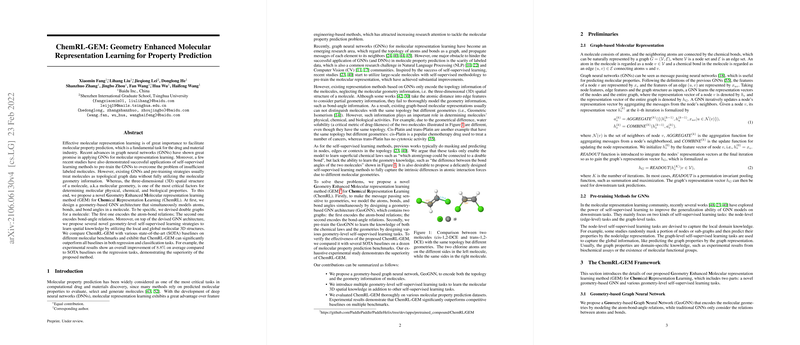Insights into "ChemRL-GEM: Geometry Enhanced Molecular Representation Learning for Property Prediction"
The paper "ChemRL-GEM: Geometry Enhanced Molecular Representation Learning for Property Prediction" presents a significant advancement in the field of molecular property prediction by integrating a novel approach that leverages the molecular geometry information. Traditional methods based on Graph Neural Networks (GNNs) have generally focused on the topological structure of molecules, often overlooking the critical three-dimensional spatial structures, or geometries, that significantly influence molecular properties. This paper introduces a sophisticated Geometry Enhanced Molecular (GEM) representation learning method, designed to address these limitations by incorporating molecular geometry information into the learning process.
The core innovation of the GEM approach is the Geometry-based Graph Neural Network (GeoGNN) architecture, which uniquely combines atom-bond and bond-angle relationships through a dual graph framework. By modeling these relationships in separate but interconnected graphs, GeoGNN can capture the spatial intricacies of molecules more effectively than previous methods. This dual-graph strategy allows for the inclusion of bond angles, which previous approaches have typically neglected.
In addition to the novel architecture, the paper introduces several geometry-level self-supervised learning strategies. These strategies focus on predicting bond lengths, bond angles, and atomic distance matrices, thus enabling the model to learn from both local and global geometric structures of molecules. This comprehensive approach ensures that the learned representations are sensitive to the spatial configurations of the molecules, which are crucial for accurately predicting molecular properties.
The empirical evaluation of ChemRL-GEM against a variety of state-of-the-art baselines on twelve benchmark datasets demonstrates its efficacy. ChemRL-GEM shows a marked improvement, especially in regression tasks that are closely tied to molecular geometry, achieving an average relative improvement of 8.8% over baselines. This suggests that the incorporation of geometry significantly enhances the predictive power of molecular models.
The implications of this work are substantial for both theoretical and practical applications. In theory, GEM bridges a crucial gap in the molecular representation learning landscape by providing a mechanism to incorporate detailed geometric information, opening avenues for further research into spatially-aware molecular modeling techniques. Practically, the enhanced predictive accuracy suggests that ChemRL-GEM could become an invaluable tool in drug discovery and materials science, where understanding subtle distinctions in molecular properties can lead to the identification of new compounds with desired characteristics.
Looking to the future, the foundation laid by ChemRL-GEM offers numerous directions for further research. One promising avenue would be the exploration of additional geometric parameters, such as torsional angles, to extend the applicability of the model to even more complex molecular systems. Additionally, integrating more accurate 3D geometric data from experimental sources, as opposed to simulated data, may enhance the model's predictions further. Another potential development could involve extending this approach to paper interactions between molecules, thereby broadening its utility in fields such as pharmacology, where understanding molecular interactions is crucial.
This paper firmly establishes the benefits of incorporating geometry into molecular representation learning and sets a new standard for methods aiming to predict molecular properties with high accuracy and reliability.
